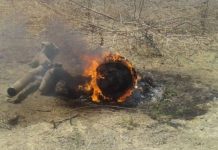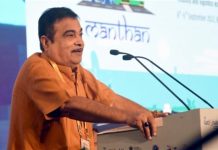 Bhima-Koregaon, a small village in Maharashtra located on the Pune-Ahmadnagar Highway, suddenly made headlines on the first day of this new year. Thousands of people from the backward Dalit caste had gathered in the village to celebrate the 200th anniversary of a battle won by the British army, mainly comprising the untouchable Mahars, against upper caste Peshwas, an event that became a symbol of Dalit pride.
Bhima-Koregaon, a small village in Maharashtra located on the Pune-Ahmadnagar Highway, suddenly made headlines on the first day of this new year. Thousands of people from the backward Dalit caste had gathered in the village to celebrate the 200th anniversary of a battle won by the British army, mainly comprising the untouchable Mahars, against upper caste Peshwas, an event that became a symbol of Dalit pride.
“We have been visiting this historic place for the past ten or fifteen years but for the very first time we noticed that all shops in the area were closed. The approach of the villagers was totally different this time. At around 11 o’clock in the morning, we saw smoke rising across the Bhima river. Some people rushed to us and said that vehicles parked there were set on fire and stone pelting was going on. We all ran towards the spot. The atmosphere had turned tensed. We informed the police about the incident, but we were surprised at the police’s role,” Vilas Sathye, who is associated with the Bharat Mukti Morcha, told Tehelka.
Bharip activist from Mumbai Ashok Gajjeti said, “We started to move towards Badu Budruk village but the situation was more dangerous there as youths were burning vehicles and throwing stones at the crowd from roofs of buildings. Cars and bikes were set ablaze and windows of vehicles were smashed. A big mob with saffron flags, chanting ‘Jay Shivaji, Jay Bhawani’ was moving towards us. Almost the same scene was being played out in Bhima-Koregaon. The crowd was stunned and people started running, a stamped took place.
Vehicles were burning and stones
being thrown even at Sanaswadi village at the connecting road to Ahmednagar. Bhima-Koregaon, Vadu Budruk and Sanaswadi were under fire. Meanwhile, news of the death of a young man made the situation more tense.”
Bharip Bahujan Mahasangh Chief Prakash Ambedkar has alleged that whatever happened on January 1 was pre-planned. “On December 31 when we came to know that some people were planning to disrupt our program on January 1, we talked to the people from the local community and appealed to them to maintain peace and brotherhood. They took the situation seriously and assured us that there would be no disturbance, but some unwanted elements spread hatred in the name of Hindutva. Sambhaji Bhide, who has been running a Hindu outfit namely Shiv Pratishthan in Sangli, and Milind Ekbote, who has also been running a Hindu organization called Samast Hindu Aghadi, are behind the planning of the violence. Bhide, who is known as Guruji, mainly brainwashed the youth of this area. He doctored history to spread hatred among the youth. A case was registered against him but arrest has not happened. We demand that they should be sued and punished.”.
In fact, an incident that took place in Budu Buduk village is behind the riots in Bhima-Koregoan and the
Maharashtra Bandh which was in reaction to the death of a Dalit youth and incidents of violence and sabotage. In Budu village, five kilometres from Bhima-Koregaon, there is a tomb of Sambhaji Raje, the eldest son of Shivaji. Aurangzeb had arrested Sambhaji and sentenced him to death. On March 11, 1689, Sambhaji’s body was truncated and thrown in this village. A decree was issued that any person who touches his body will also be killed. According to historical texts, a person named Govind Gopal Mahar, a backward caste from this village, collected his fragmented body pieces and cremated them. Govind Gopal Mahar’s tomb is built at a short distance from king Sambhaji’s.
On January 1 every year, members of the backward castes gather at the Jay-stambha, an obelisk commemorating the battle of Bhima-Koregaon, and go to Badu village to pay obeisance at the tombs of Sambhaji Raje and
Govind Mahar. Some people had also built a shed at Mahar’s tomb. There was also a flax banner giving information about him. On December 29, three days before violence broke out, an attempt was made to desecrate Mahar’s grave.
This led to tension in the village.
In this case, a case under the SC and ST (Prevention of Atrocities) Act was filed against at least 49 youths in the village. According to sources, this matter was publicised by spreading misinformation that upper caste Marathas were being targeted by misusing the pro-backward caste Act. However, in reality youths from the OBC community along with Marathas and other communities were also involved in the incident and booked accordingly. Along with Badu village, people from nearby villages were also provoked in this manner, which resulted in stone pelting and burning of vehicles of the people who had come to celebrate the day as Vijay Divas.
Even before December 29, there was a case of tampering with history in Badu village. It is being propagated here that Sambhaji Maharaj’s cremation was not done by a Mahar but by a villager named Shival Deshmukh, originally from the Shirke caste, and other Marathas. There is, however, no historical evidence of the claim. Govind Gopal Mahar has been mentioned by many historians in their research. Historian B C Bendre has written that the work of Govind Gopal Mahar was mentioned on the board on the tomb of Maharaj Sambhaji. But two years ago, the old board was removed and a new board was placed, which replaced Govind Gopal Mahar’s name with the word ‘Shivay Gramastha’. The allegation is that all this has been done at the behest of Sambhaji Bhide and Milind Ekbote, who want to spread Brahmanical supremacy. Bhide denies the allegations, demanding a CBI investigation of the entire incident.
Kumar Kale, associated with BAMCEF, an organisation working for exploited and pressed communities, claims that he has strong evidence against Bhadra and Ekbote.”We have gathered the evidence which will prove that both of them have a hand behind whatever violence took place on January 1. Not only that, the attitude of the local police was to help them indirectly. We are going to drag them to court,” he said.
Prakash Ambedkar asks, “If Jignesh Mewani has called the BJP and the Sangh in his Elgar Rally held in Shaniwarwada, Pune, as modern Peshwas, then what is wrong in it?”
Ashok Gajjetti explains, “Bhima-Koregaon’s war was between Peshwa and the British, but in this battle,
Mahar soldiers while fighting for the British took revenge for the atrocities committed by the Peshwa on Dalits. Almost two-and-a-half-thousand Peshwa soldiers were killed by nearly five hundred Dalit soldiers. During the time of Peshwas, to humiliate the Dalits as untouchable they were made to walk with a pot hanging from their necks and swabs from the waists.”
To make their victory in the Bhima-Koregaon battle memorable, the British constructed the obelisk. Dr B R Ambedkar used to visit it and had linked it with Dalit pride. Since then, Dalits have been paying tributes at the victory memorial.
Bhima-Koregaon violence and its counter-violence has not only impacted Maharashtra but national politics too. About 4,000 people from Maharashtra have been arrested in connection with the violence and disruption during Maharashtra Bandh. As a result, the atmosphere is tense. It is being seen as a challenge to growing supremacy of pro-Hindu political parties and organizations. Other political parties do not want to miss the opportunity to take advantage as the general elections are to be held next year.
letters@tehelka.com













